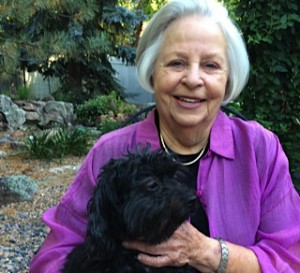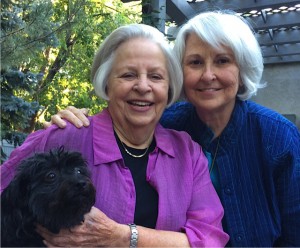Monday
Community ArticlesWith Force of Character…
COLUMN: Aging in Enlightened Society
article by Nan Clydesdale
It is not by muscle, speed, or physical dexterity that great things are
achieved, but by reflection, force of character, and judgment; in these
qualities old age is usually not only not poorer, but it is even richer.
— Cicero
At the age of 82 years, Martha Hildreth embodies genuineness and is unwilling to compromise her integrity in order to satisfy the expectations of others or win their approval. She will consistently say what she means, do what she says, and say what’s so when it’s so.
It is out of force of character that Martha started an addiction recovery group at the Denver Shambhala Center almost fifteen years ago. Back in 2000 five people showed up; today as many as forty attend weekly recovery meetings. She recalls she began this work at the direction of her friend and teacher, Pema Chodron. In 1999, Martha asked Pema what she should do for the sangha and for her own Buddhist path. Pema told Martha that Shambhala would benefit from someone who understood addiction and Buddhism and that was her job: to bring awareness of addiction to the Shambhala sangha.Martha has thirty five years of recovery from alcoholism, step work and sponsorship, as well as twenty-two years on the Shambhala path, serving our community as a Meditation Instructor and Teacher. Before retiring, Martha was a program consultant and addiction counselor at a rehab treatment center in Tucson.
The sky was a clear Colorado blue and her garden ablaze with fall color when Dave Garton interviewed Martha about her 12 Fold Path work and how it has affected her personally. Dave has been in recovery and a Shambhala Buddhist for thirty years. He regularly attends the Wednesday night recovery meetings at the Denver Center.
When we met with Martha we wanted to know how she sustains her generative energy and how she wards off acedia – that mental sloth that sometimes takes hold in old age. We wanted to understand her role and the evolution of the Center’s addiction recovery program she named the “12 Fold Recovery Path – Sarpashana.”
Dave: How did you connect sobriety with the dharma?
Martha: My sobriety predates my Buddhism by quite a bit. I got sober in 1979 and started the Buddhist path in 1992. Once I became really serious about studying Buddhism, I totally stopped attending 12 Step meetings – for about 10 years. I felt I was on a path that was very enriching and fulfilling and I didn’t need any 12 Step involvement. And then one day it just occurred to me that I had lost a sense of self honesty. It was very subtle and very slow but I realized one without the other was not a good idea for me. And so I started to attend meetings again and today I meet once a week with a group of old ladies like me.
The level of sharing of how you are feeling and what’s really going with you is unique to 12 step work. It’s not a core requirement in Buddhist practice. Those years of not doing it, it was amazing how my old habits and old ways of doing things seeped back in. I need both traditions.
I tell new people that our recovery meetings at the Center are not a substitute for the 12 Steps. I strongly encourage people to do their 12 step work in addition to studying Buddhism and learning how to be a meditator.
Dave: When other Shambhala centers call you to ask about setting up their own recovery meetings, what do you tell them?
Martha: We start each meeting by sitting for 1/2 hour. I give about 10 minutes of instruction, working with posture, helping people relax into being there. I don’t prepare for the meeting. Each week someone in the group takes the lead to bring a topic for discussion and they bring a number quotes to be read out loud. I tell them it can be from either 12 Step literature or Buddhist literature, or ideally both.
During the meetings I listen carefully to what is being said, but I don’t interject unless something is getting out of hand, which rarely happens. To tie things together at the end of the meeting, I often use an antidote to clear up any confusion that may have arisen during the discussion and sharing.
Because there are new people in the room each week, I have the opportunity to introduce the nature of basic goodness over and over again while giving instructions on why we close with a bow to each other and the Dedication of Merit.
We schedule a monthly 1/2 day meditation program which is totally Buddhist oriented instead of a combination of the two. A week does not pass that I don’t get a call from someone asking about our recovery meeting. They see the 12 Fold Path description on the Center’s webpage and want to know more. The word’s out that it’s a great meeting. It’s not about me. It’s because of the level of sharing that goes on at our meetings.
Dave: The group you started has a flavor of attraction and not promotion. I have to say this Wednesday night meeting is the most Buddhist place I go to. What do you think is going on in these meetings?
Martha: There is a modeling of honesty and bringing out in the open deep issues that people are grappling with. One person opens up and pretty soon half the room has shared in an in depth and meaningful way about what is going on with them. Buddhism teaches we need a sangha. The 12 Step program teaches us we are unlikely to stay abstinent alone. There is a melding of the two. I also think because we are sitting for half an hour before the discussion starts, it softens people so that they are even more open.It’s interesting that more than 95% of the people who attend the Center’s recovery meetings are initially not a part of Shambhala. It has not been the draw from our sangha as you would expect. I think too many people in our community with addiction problems think their Buddhist path is enough and the 12 steps are just training wheels. Some may stop drinking or pills for a while but frequently relapse. I think 12 Step work is a profound adjunct to mindfulness and learning to be yourself and learning not to be afraid of who you are. From my own experience, both are very powerful and complementary to one another.
Dave: In the early years I wanted the teachings and to learn to mediate but I had to stay away from the sangha to stay sober (because of the culture of heavy drinking). But now when I go to dathun, recovery meetings are offered. There is nothing more lonely than being in a meditation hall thinking you are the only alcoholic. And there is nothing more relieving than wandering into a Heart of Recovery meeting to find other people sitting there with an addiction, like you. You go back into the shrine room the next morning and can relax without the sense of isolation. The awareness of addiction is much greater and the sangha is so much more considerate today. To a large part this is because of you, Martha.
Martha: One of the reasons why recovery groups work is because your terminal uniqueness drops off – you learn to see who you are and what you are struggling with. And this breaks down the isolation.
Dave: Looking back over these fifteen years, what has this 12 Fold Path work meant to you?
Martha: Every day it becomes more significant to me. This work has given me an opportunity to feel useful, to have purpose, to feel vital. During the Wednesday night meeting, I need to be on my toes, to be present. I am listening and picking up all kinds of subtle ripples that go through the room. It has helped my mindfulness practice tremendously.
I haven’t done so yet but I need to tell Ani Pema how grateful I am to her. I went into this work kicking and screaming. Bringing addiction awareness into the Shambhala community was something I didn’t want to do. But when you trust your teacher, ask what to do and they tell you, if it’s an authentic teacher, you will benefit immeasurably.
It has also helped me with my meditation instruction and directing Shambhala training levels. Doing 12 Step work is the most effective tool I know to be authentic. My teaching comes from a feeling rather than intellectual approach and to be authentic, you need to be in touch with your feelings and not be afraid or ashamed of who you are.
I urge older people to connect to some endeavor that takes you out of yourself (aches and pains and everything else that’s beginning to fail). As the Sakyong teaches, if you want to be happy, think of others.
Doing this work has helped me stay connected, to stay interested. And that goes a long way to feeling good about being this age. I don’t plan to quit.
Read more about the Heart of Recovery by clicking here.
~~Nan Clydesdale is the CareTeam Coordinator for the Denver Shambhala Center and was one the members to start up the Wisdom of Aging group in 2011.










Oct 21, 2014
Reply
A great heart! Thanks for sharing. I am sharing this on pinterest.
Oct 20, 2014
Reply
Sounds great.